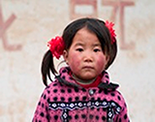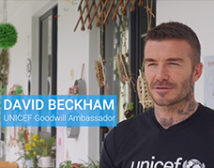Children are often the most astute observers of change.
For 15-year-old Yang Xiang'ai, a student at Caoyang Primary School in Gansu Province's Xihe County, the most significant change to take place at her school in the past few years is obvious. "I like to sing and perform. A few weeks ago, we were studying the text of 'Wusong Fights the Tiger' [from the Chinese literary classic Outlaws of the Marsh] in Chinese class, and our teacher asked us to act it out. I got to perform the lead role!" She playfully made the hand motions of the heroic Wusong defeating a man-eating tiger.
|

©UNICEF/CHINA/2011/Yan Lu
A child-friendly classroom where children become active learners |
"In the past, whenever we had Chinese class, we were always in our seats. At most, our teacher might assign us different parts of the text to read. To tell you the truth, our lessons were not that interesting. But now, we are given the chance to perform in front of the class. All of my classmates and I are very excited about the change. I hope that I have the chance to perform more roles in the coming months!" Yang Xiang'ai said.
In the three years since the 2008 Wenchuan earthquake, UNICEF has supported a comprehensive "Building Back Better" education programme in the most seriously-affected counties. Big changes have taken place during this time, as freshly trained teachers have been able to introduce new, child-centred teaching methods to the classroom. The changes brought about by the UNICEF-supported Child Friendly School approach have been thoroughly integrated into the education reconstruction plan, bringing lasting changes to schools throughout the earthquake zone.
"I'm trying to provide opportunities for my students to think critically"

©UNICEF/CHINA/2011/Yan Lu
A child-friendly classroom where children become active learners. |
"In the past, we relied entirely on traditional teaching approaches. Teachers stood in front of the classroom and lectured, while students took notes. Every question had a standardized answer, and students were expected to memorize that one answer. Now, the situation is totally different. I'll ask questions, but I don't give a standardized answer immediately. In fact, many of the questions that I ask don't have a single correct answer anymore. Instead, I'm trying to provide opportunities for my students to think critically and participate in discussion," said Nan Lu, a Chinese teacher at Gutang Primary School in Xihe County.
Since the earthquake, UNICEF has supported training for Ms. Nan and her colleagues on interactive teaching, a key component of the Child Friendly School approach. The Child Friendly School approach that has been introduced to the earthquake zone aims to replace the rote teaching methods in place before the earthquake with more inspiring pedagogy and provide young children with a more exciting, more rewarding time in the classroom. "Through the training, we learned about the importance of child participation and student-teacher and student-student interaction. I've found that the new approach works very well in practice," said Ms. Nan.
One way that the Child Friendly School approach encourages student participation in the classroom is through "effective questioning." At Leigu Central Primary School in Beichuan County, Ms. Yang, a fifth-grade teacher with 13 years of experience teaching Chinese said, "I've been teaching the text 'Marie Curie Discovers Radium' for many years now. In the past, I'd have students open their textbooks to that lesson, and I'd begin lecturing. Now, I'll let them first preview the lesson, then allow time for them to have a discussion and pose questions. The students are asked to keep their questions as we study the text. This way, students are actively engaged throughout the learning process. I've found that this helps them to understand the text better."

©UNICEF/China/2011/Yan Lu
A girl studies attentively during a class session. |
The changes that have been brought about with the introduction of the Child Friendly School approach are apparent, not only in the teaching methodology, but even in the physical layout of classrooms. In many schools, the traditional rows of desks and chairs have been replaced with clusters of four or five desks, which facilitates student discussion and interaction. "Ever since the layout of the classroom changed, I've become less afraid of my teachers and brave enough to speak up in class," said Yang Yupeng, a fifth-grader at Yangzui Primary School in Xihe County.
"My son is an active learner"
Today, Zhaohe Primary School is located in a sturdily built building, newly constructed after the earthquake, with a brick-lined path, a beautiful flowerbed and a UNICEF-supported playground. During recess, all the students gather at the playground and play basketball, volleyball and table tennis. For them, the playground and the sports facilities provided with UNICEF support will likely remain a part of their happiest childhood memories. "I love the playground. I come here every day, and hope that I'll still be able to play here after I go to middle school," said fourth-grader Jiang Xiongbang.
Three years ago, it would have been impossible to imagine that Zhaohe Primary School would ever undergo such a transformation. According to Principal Guo Shoucheng, the school sustained serious damage in the earthquake. With the collapse of several mud and earth buildings in the area, dust was everywhere in the months after the earthquake. Whenever it rained, the entire ground became mud.
Inside the school, facilities were equally poor, especially for the preschool-aged children, whose classrooms were devoid of age-appropriate supplies. Even the youngest children used the same chairs and desks as the fifth and sixth-graders, their feet not quite reaching the floor. Today, however, the scene is totally different. The preschool classroom is filled with age-appropriate toys, and colourful children's drawings adorn the walls.

©UNICEF/CHINA/2011/Yan Lu
A boy laughs during a class session. UNICEF has introduced the child-friendly approaches into schools in the aftermath of the earthquake to help improve the education quality. |
Preschool teaching methodology has also changed completely. "In the past, we focused on teaching pinyin [the romanization system for Chinese characters] to preschool students. Since the training, the focus has shifted to games for young children that help them develop cognitive, emotional and other skills," Principal Guo said.
In the primary grade classrooms, big changes are afoot as well. Through the UNICEF-supported training on Child Friendly School development plans and school management, Principal Guo learned about curriculum planning, new classroom teaching approaches and supportive school management practices. This has led to a revolution in school management at Zhaohe Primary School.
With all the changes in school management and classroom instruction, however, also came some discomfort from parents, who were more familiar with the traditional way of teaching. "How can children learn unless they're given more books?" was a common complaint raised by parents. In response, Principal Guo held a meeting at the school and invited parents and community residents to attend. At the meeting, Principal Guo explained the concept of Child Friendly Schools and showed parents the positive learning outcomes achieved for children.

©UNICEF/China/2011/Yan Lu
A school safety drill in one of UNICEF-supported schools. |
Jiang Bizhan, the father of fouth-grader Jiang Xiongbang, was present at the meeting. "Huge changes have taken place at Zhaohe Primary School. I see now that my son Xiongbang is an active learner, not a passive recipient of education. I see that Xiongbang has gained creative problem-solving skills. I've also just found out that my son has drawing talents that I never noticed before," he said.
Today the school, family and community work together to provide the students of Zhaohe Primary School with a supportive, child friendly learning environment.
By Cheng Jing

































